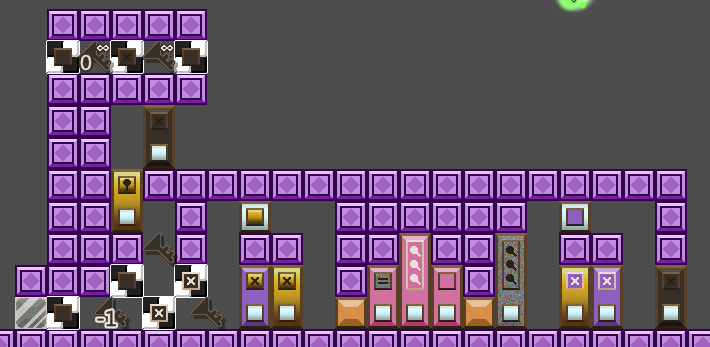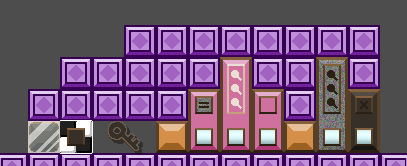The "Focal Point moment" at the end of The Dream Labyrinth is a bit different: you find a Spirit with a curiously large elevation jumping Curse, then go to the right place and get the Curse to trigger, and the elevation jump takes you... back to the Great Beyond hub, but with your inventory preserved. This allows you to enter a door there you couldn't previously enter, and from there the game is on: rather than collecting Omega Keys, the post-T4 meta exploration involves jumping around between various rooms across the game, bringing in inventories you shouldn't have and jumping to locations you shouldn't be in, to break levels in new ways and go outside of the level's usual coordinate range to find hidden objects tucked in formerly out-of-bounds areas. Hub entrances (any of the 12 entrance types with H for its backspace type) were previously considered off-limits even in the Dream Labyrinth, but now they play a major role.
The permanent progression things to collect here are "dream sections", but the first few you get don't seem to do anything. However, once you get enough of them, you unlock The Cool Place, which is significantly different here: in IWL:TMC, The Cool Place is a single room/level, but a customizable one. Those dream sections are pieces of a level, i.e. arrangements of key pickups, doors, etc. Secret Lab is unlocked alongside The Cool Place, and from the Secret Lab you may edit which dream sections appear in The Cool Place. Through the rest of the post-T4 meta exploration, there will be some entrances to The Cool Place, so you'll often need to choose your Cool Place layout correctly so you can use it to help get past whatever obstacle is in place back in the area you entered it from. Note that the Secret Lab and the Cool Place are not immediately connected via entrances (both are places you can warp to), so usually you can't edit your Cool Place while in the midst of solving a metapuzzle that requires it.
I'm not sure what the Kina's Heart equivalent is here. That puzzle definitely involves using entrance and Spirit jumping shenanigans to smuggle things into the main hub that aren't supposed to be there, but there are no Master Keys or Brown Keys, so what exactly the puzzle is has to be different. Regardless, Return to Doorhaven exists. Like Doorhaven itself, Return to Doorhaven doesn't have a concrete theme, but I do have to stick to it introducing new non-meta mechanics.
So, what Return to Doorhaven introduces is Typed Usable Items. "Usable Items" here means Buckets, Seeds, Etches, and Gears, the items that you can use to alter the characteristics of other objects. Normally, Buckets and Etches are "door-type", Seeds are "key-type", and Gears work on any of Doors, Scanners, and Filters. Return to Doorhaven introduces variants of these items that work on other objects: Door-Type Seeds to copy or destroy copies of doors, Key-Type Buckets and Etches to alter the colors and numbers of key pickups, Scanner-Type Buckets and Etches to edit the colors and numbers of specific "locks" within a Scanner statement, Filter-Type Buckets whose colors correspond to non-Key items instead of Key colors, Dispenser-Type Gears whose negatives cause the Dispenser to deactivate on its next dispensing (and deactivated Dispensers that you have to use positive Dispenser-Type Gears on to get them to dispense their next item), "Blocker-Type" Buckets that work on any of Doors, Scanners, or Filters (Blocker type is what Gears are by default), Moonstone-Type Etches that let you alter how many phases a Moonstone increments by, Moonstone-Type Buckets that let you color a Moonstone so it only increments the Phases of things that are currently that color, Spirit-Type Seeds to make a Spirit need to trigger its leaving effect multiple times before it actually leaves, and so on. This also means that just about anything can have the Star property to protect it from the above. Finally, there are "Metabuckets", which come in types instead of colors, and are used on a pickup usable item to change its type to match the type of the Metabucket, so you can convert items of one type into items of another type. There's definitely some kinks to this idea that need to be ironed out here, but I think these item types could work as the Return to Doorhaven mechanic for Theme-Mechanic Converse.
Garden of Dreams's first half introduces the final collectable item, Dream Clouds. Dream Clouds are basically collectable entrances: like a regular entrance they have some number they change your elevation by (or set it to if Blueprint) and are one of the 48 types, but rather than being enterable, a Dream Cloud is collected and added to a special inventory when touched, and you can then access that inventory and choose to use the Dream Cloud whenever and wherever you wish (it's removed from your inventory when used). Your Dream Cloud inventory is reset upon inventory loss. Garden of Dreams's second half, which you need to have beaten Return to Doorhaven to access, throws in Cloud-type versions of the usable items, allowing you to edit what elevation entrances and Dream Clouds go to with Cloud-type Etches (and use Cloud-type Seeds to copy O entrances, etc. I'm not sure what a colored entrance does... maybe Cloud-type buckets change one of an entrance's four properties instead of color?). These mechanics combined make it so that, whereas The Dream Labyrinth was about navigating the maze to find your way between levels, Garden of Dreams is about choosing what levels/elevations/rooms to go to in the right ways using the right entrances and Dream Clouds.
Bridge to New Memories takes place in the sky on clouds, so here it's a final puzzle about Dream Clouds and other entrances, having you use Dream Clouds and Cloud-Type Etches to go back to various points across the game to collect the right keys, items, etc. to meet the requirements at the end.
Lockpick Horizon is still a postgame world so it doesn't technically introduce anything new, but in practice it does: here, you stare into the endless horizon of elevation and leap deep into it, courtesy of Operator Entrances and Operator Dream Clouds, which can do general Operator Key things to your elevation - so there becomes complicated math about getting to the right elevation to get to the next puzzle. I don't understand Kina's Masterpiece well enough to comment on how it works in Theme-Mechanic Converse. Perhaps the postgame ends with an Operator Entrance that divides your elevation by 0, causing an error that takes Lily back to the surface, thus truly ending the experience?
OK, was this all realistic? Definitely not, I stuffed too many mechanics into some of these worlds. If I had to cut back on some of this, I'd remove Messes, somehow move Seeds into a separate world from Negative Garden (perhaps necessitating a rebrand - maybe they could be "copiers" introduced in Lockpick Library?), remove Operator Keys (as sad as it would be to see the more math-y things go… and I guess Lockpick Horizon would just go back to being a standard postgame world without elevation shenanigans), remove "multiple elevation objects"/Shadows, remove Spirit Summonings (or remove Blessings and Curses but keep Summonings), probably remove Gears, and maybe even remove Phases (which would probably necessitate breaking the cloud pair symmetry in Mooncloud Lake so it's actually introducing something meaningful instead of waiting until Etchstone Cliff to do so, and then collapsing clouds are the only part of elevation mechanics that Etchstone Cliff adds). With Part 1 I definitely prioritized "one mechanic per piece of the theme, or two mechanics per world" over keeping the worlds at a realistic size - but that's kind of the point, isn't it?



